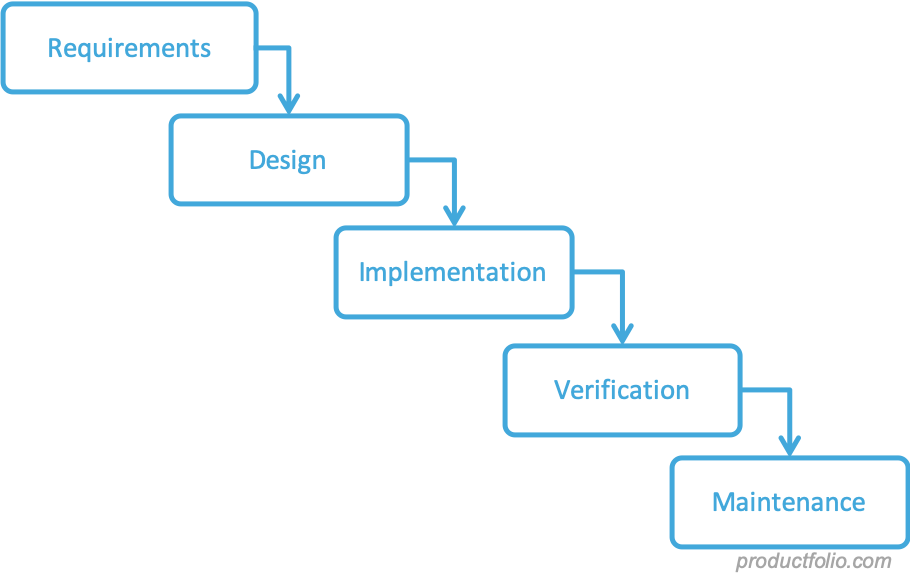What is Waterfall Methodology?
The Waterfall methodology is a “stage gated” process that requires you to complete the first activity before going onto the second activity and so on in sequential order until all of the activities are completed. It’s intended to organize the workflow through a distinct series of phases. While Waterfall makes the most efficient use of resources, it can be slow in creating value due to the inability to move in parallel.
This approach is ideal in areas like construction where things must move in sequential order, like laying the foundation before the first floor, and then the second and so on. In fact, the Waterfall development model originated in the manufacturing and construction industries and became a standard due to the highly prohibitive cost of changes throughout the development process. Herbert D. Benington introduced the Waterfall method for the development of software in 1956 at a presentation about the development of software for SAGE. There were not any alternatives at that time, and the Waterfall method became a standard.

The Six Phases of the Waterfall Model
When the Waterfall process is applied it goes through six sequential stages:
- Requirements Analysis – This phase determines what needs the product will address, what problems will the product solve, and what functions/features do the users desire?
- Design – This phase looks at an abstract representation of how the data will flow within the product is designed.
- Implementation – The engineers build and create the product based on the information from the approved and completed the first two phases for the implementation phase.
- Testing (Validation) – In this phase, the product is presented to users to test out and try. If there are any requirements that aren’t met the product goes back to the engineers.
- Deployment – This is the phase where the actual product is released into the market.
- Maintenance – The final stage is the stabilization phase, where issues and bugs are worked out and solved.
With each stage being sequential and distinct, it flows steadily downwards like a waterfall, hence the name. During this progression, you will see emphasis focused on things like schedules and target dates because the entire product will be implemented all at once at the end. It’s important to note that each phase has a review and sign off process before moving onto the next phase.
Waterfall vs. Agile
The Waterfall process moves in a steady downward direction with well-defined stages, while Agile is a cross-functional collaborative process that takes a team and sprint approach. Waterfall is the traditional process used in Product development since the 1960s and is commensurate with practices such as the traditional Product Requirements Document (PRD). The majority of Product Development efforts have progressed to an agile framework due to its collaborative and iterative approach – at least in the field of digital/software products, which benefit from rapid feedback loops and do not have the same cost and complexity of distribution.
Benefits of the Waterfall Method
Thorough documentation, accurate timing, and perceived predictability are often the key reasons that Product Managers still use the Waterfall method. This process also provides deliverables for management at each stage in the game which can help to create reassurance for the Product throughout the process.
The Risks of using the Waterfall Method
There are clear benefits to using the Waterfall approach like scheduling predictability and clear and concrete stages. That said, there are some inherent risks to this approach as well.
Product Discovery – Product discovery is limited to the very beginning of the project and cannot adaptively reflect how feedback changes as the product matures. This leads to a culture that de-emphasizes customer-driven feedback, all of which can lead to poorer product-market fit.
Late Stage Validation – The Product is not tested and validated until the end of the process which can be costly and wasteful if the product is not successful. Although Waterfall can yield the most efficient use of resources to deliver a known execution – it can also yield the most inefficient business outcomes, fur new products with unknown market-fit that requires discovery
Disruptive Changes – If it’s found that changes need to be made in the testing phase it can be disruptive to the process since the product then has to go back to the design and implementation phase instead of continuing onto the planned deployment phase.
Market Adjustments – The Waterfall method requires that each stage be approved and completed with documentation as it progresses through the stages making it difficult to do quick changes in response to the market when the product is launched.
Conclusion
Waterfall product development is a traditional method of development that traces back to physical CPG products in the 1960s. The process is analogous to the factory assembly line and excels and making good use of resources for the development of a known commodity.
This approach rose to prominence in the 1960s and reflects the ethos of the time, which was more mass-market focused and more focused on the development of physical products that require strict control of materials and distribution. The rise of the Internet product industry changed a lot of this starting in the 1990s, with both the rising popularity of Lean methodology that is rooted in Just In Time manufacturing processes that were becoming better known in the 1980s, and the radically simpler distribution that was afforded by the Internet and made iterative delivery possible.
Despite the recent popularity of iterative methodologies, Waterfall is an important tool in the arsenal and is still sometimes the best approach for large internal delivery initiatives that do not benefit as much from rapid customer feedback or require tight control of materials or distribution.


